In the limbo under, it’s how low can you go.
In the Subaru Forester Wilderness, it’s how high can you go?
This new iteration of Subaru’s popular crossover wagon has as much clearance – 9.2 inches – as some 4WD SUVs and trucks.
Without the cost.
What It Is
The Forester a compact sized crossover – of which there are many, including similar-sized models like the Honda CR-V, Toyota RAV4, Mazda Cx-5 and Nissan Rogue. It is the only crossover in the class that offers as much airspace between its underthings and the pavement. Or dirt. Or snow.
Which accounts for why it is more likely to keep moving when the others get stuck. 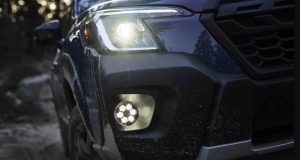
It is also the only small crossover with a standard boxer engine – a type of engine that’s also a flat engine. The layout lowers the Soobie’s center of gravity. The weight of the engine being equally distributed on either side of its centerline also increases its stability.
This makes it somethings the others aren’t – which helps it stand out from all those others.
Prices start at $25,395 for the base trim – which includes all-wheel-drive. In many other crossovers, it’s available – optionally.
And costs extra.
The new Wilderness trim – which stickers for $33,020 – also comes standard with 9.2 inches of ground clearance (8.7 inches in other models) as well as five wheels – including a full-size spare with a full-size tire on it, not a “temporary use only” donut spare or a useless (if the sidewall is damaged) tire-inflator kit, as many others come standard with.
The Wilderness also gets a higher (3,000 lb.) tow rating, a more aggressive 4.11 (vs. 3.7:1) final drive ratio, StarTex water-resistant seat covers, raised roof rails, underbody skid plates and LED fog lights, among other upgrades.
A top-of-the-line Touring trim comes standard with a premium Harman Kardon audio rig, heated rear seats and a heated steering wheel.
It stickers for $35,495.
The Wilderness trim is the newest form of Forester, meant to make this already capable all-weather (and off-road-capable) crossover even more so.
And look so.
All trims receive a minor exterior cosmetic refresh and heavier-duty roof rails rated to carry heavier loads.
What’s Good
Much more capability than other crossovers.
Unique drivetrain.
Attractive base price given what’s included, especially the standard AWD.
What’s Not So Good
Others in the class – such as the Mazda CX-5 and the Nissan Rogue – offer stronger engines.
All trims come standard with the same engine – and transmission.
Other trims have half the rated towing capacity of the Wilderness trim.
Choosing which engine/transmission/driveline to get in a new Forester is easy – because Subaru has done that for you. All six trims come with the same engine/transmission/driveline.
This is mostly a good thing.
The 2.5 liter, 182 horsepower boxer four cylinder engine isn’t turbocharged – yet it’s still horsepower-competitive with the turbocharged engines in rivals such as the CR-V (1.5 liters, 190 horsepower) and Nissan Rogue (also 1.5 liters, this time 201 horsepower) while being gas mileage-competitive as well.
The Soobie rates 26 city, 33 highway; the turbo’d Honda CR-V rates 27 city, 32 highway – with its optional AWD. The Rogue comes in at 28 city, 34 highway – also with its optional AWD system.
So the turbo’d alternatives don’t give you much in return for the turbocharging – which increases the load on the engine as well as parts bolted to the engine. This could increase costs – on you – at some point in the future, when the engine needs new parts, such as a new turbo.
Or maybe even a new engine.
The Mazda CX-5 is probably the closest shave for the Soobie in that it, too, comes standard with a non-turbo’d 2.5 liter engine – that makes 187 horsepower. Which can be boosted – if you like – to as much as 256 horsepower, via the optionally available turbocharged version of this engine. 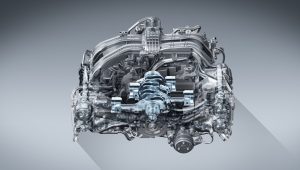
However, the Soobie’s engine is the only boxer engine of the bunch. To find another crossover that offers this type of engine, you’d need to head on over to your local Porsche store – and that’ll cost you about twice what you’d pay to get the same type of engine in a Forester.
A boxer engine is called that because its cylinders aren’t lined up in the usual row or in a “v” configuration, standing upright or mostly so. Instead, they are laid flat and with each cylinder opposing another on the other side of the crankshaft, back and forth. This layout was made famous by VW – in the original Beetle – and of course, by Porsche. It allows for a compact, low-mounted engine that is also naturally balanced and for that reason is lighter than the in-line/upright equivalents. All of these factors aid in balance and handling as well as giving the car a unique growly sound that establishes emotional separation between one so equipped and the rest. 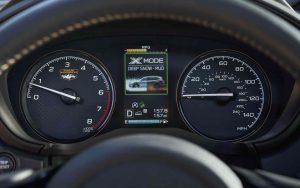
Another point of separation – from most of the rest – is that Soobie comes standard with AWD.
Others – like the CR-V and Rogue – offer it, at extra cost. And the kicker is they cost more, already – in front-drive trim. For example, the FWD version of the CR-V stickers for $26,400. With the optional AWD system, its MSRP rises to $27,900. The AWD-equipped Rogue costs even more – $28,350.
That’s about $3k higher than the AWD-standard Soobie.
Mazda’s CX-5 comes closest, again. This rival also comes standard with AWD and its base price of $25,900 is only a few hundred bucks higher than the base price of the Subaru. But if you like the idea of a boxer engine under the hood, the Soobie is priceless.
Most small crossovers aren’t rated to pull very much but the Forester can pull more than most . . . if you buy the new Wilderness trim.
It carries a 3,000 lb. maximum tow rating. This is twice the standard tow rating and twice the maximum-rated capacity of rivals like the CR-V and Rogue, which both max out at 1,500 lbs.
The Mazda CX-5 is (once again) the Soobie’s toughest rival. It comes standard with a 2,000 lb. maximum tow rating – which is 500 pounds more than what comes standard with all version of the Forester except the Wilderness – which is priced several thousand bucks higher than the Mazda as it sits.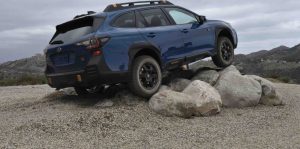
On The Road
It’s more about where you can go off-road.
Also, whether to risk the road when it’s underneath half a foot of freshly dumped snow. That’s what this Soobie is all about – especially the new Wilderness iteration, which has 9.2 inches of clearance, enough to leave several inches of clearance between that half-a-foot of snow on the road and the underside of this intrepid little crossover.
Which is fitted just the right shoes for such work, too. Seventeen inch Geolandar all-terrain tires grab the terrain at all four corners.
These tall sidewall tires – 225/60s – are meant to give and flex with terrain – and because of that, they also ride soft on the road. This gives the Wilderness what would once have been described as a luxury car ride. Today, luxury-sport cars have short-sidewall tires that are very stiff for that reason and for just that reason ride like the sporty luxury cars they are.
It’s weird – and welcome – to find out just how luxurious-riding this Subaru is.
Seriously.
Drive it on a bad road and see for yourself. Hit a deep pothole on one of what’s left of America’s roads and see how how little you feel it. Drive it on an unpaved, washed-out gravel road and the Soobie’s civility will astound even more. It is one of the most pleasantly capable vehicles I’ve driven in years.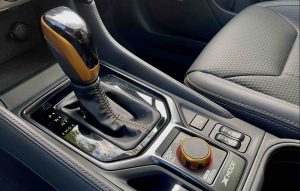
With one exception.
There’s not much reserve on tap to execute a quick, high-speed pass around a Clover Conga led by a car doing not much speed at all, say 48 in a 55. You’ll need precious time to build enough speed to make it around one such in time. If there are two or three of them ahead of you, the difficulty waxes.
The engine has adequate power for everything else.
A manual would let you make the most of what’s available but it’s not available. This is also true in the class, generally. Some of the competition does offer more power but it comes with a turbo – and everything else that comes with that.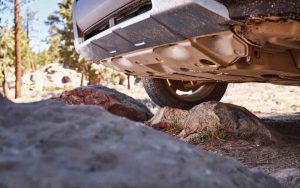
Driving the Soobie is a more engaging experience in that you must learn to depend on your ability to gauge time-distance relationships and make fullest use of the car’s available gumption. This can be fun in a way that driving a car with more-than-adequate power isn’t because you’re more challenged, as a driver.
The only thing that’s not fun is having to turn off ASS – automated stop/start – every time you start up the thing – unless you don’t mind the engine stopping (and re-starting) every time you stop the thing.
Like other crossovers in the segment, the Forester is all about making the most of the space you’ve got. Which is a lot given that it’s about the same size – well, the same overall length – as a typical compact-size sedan, something like a Honda Civic. But in spite of being only 182.7 inches long (a Civic sedan is 184 inches long) it has about twice as much space for cargo (28.9 cubic feet) as the Civic does (14.8 cubic feet) and that’s without counting how much more space you have available if you drop the Soobie’s rear seats. This expands the total space available to 74.2 cubic feet – about five times the space for cargo vs. a same-size small sedan such as the Civic.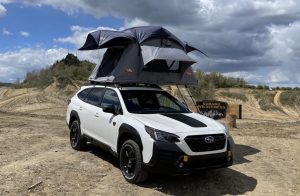
Unlike other crossovers, the Forester doesn’t look like them – if you get the new Wilderness version. The knobby (and raised white letter, if you like) tires alone make it look unlike the others, on account of the unusually tall sidewalls and the amount of air gap between the tires and the wheelwells.
It almost looks lifted – and in fact, it is.
Other versions of the Forester have 8.7 inches of clearance – still more than most other crossovers. But the Wilderness kicks that up to 9.2 and that’s a difference you can see, especially with those tires.
Wilderness iterations of the Forester also get rubber-armor around the wheelwells and front and rear lower bumper areas, which of course are the areas most likely to get scuffed – if they were painted. Inside, the seats are armored against water; if you get wet, the seats won’t soak it up.
If you dinna like – and dinna want – a flatscreen gauge cluster you will like this Subaru’s still analog speedometer and tach; similarly, the refreshingly physical gear selector and adjuster knobs for the AC and heater.
There is even a CD slot.
There’s an LCD touchscreen, too – but it’s peripheral, as these things ought to be. You do not need to tap/swipe to change radio stations (or turn on the seat heaters) while driving. This makes the Subaru a safer to drive car – as opposed to using technology such as Lane Keep Assist to correct for people too busy tapping and swiping while driving.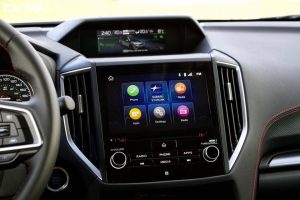
The Forester – all trims – comes standard with Lane Keep Assist, as well as a number of other electronic “assistance” systems, all of which can thankfully be turned off. If you need such “assistance,” you’re probably not paying attention
These systems – unlike ASS – remain off, once you’ve turned them off. It is not necessary to turn them off every time you start the car if you don’t want them on.
You can’t get rear seat heaters in the Wilderness – an option that’s offered only with the Forester Touring (which is also available with a gesture control interface that let you operate the climate controls without actually touching any controls). But the Wilderness is the only Forester trim that comes standard with a real spare tire, which can be just as handy on road as off.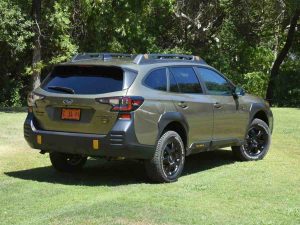
The tire inflator/repair kits that many new vehicles come with are great if you run over a nail but useless if you blow out a sidewall as by popping a curb or hitting a really bad pothole.
The Rest
Cost was mentioned earlier – and it’s quantifiable in more than just dollars and cents. The as-it-comes $25k-ish Forester offers poor weather/unpaved roads capability that approaches that of 4WD trucks and SUVs – for thousands less than most of them cost. Not counting the cost of feeding a truck or SUV in these Let’s Go Brandon! days.
The luxury-car ride quality of the Wilderness trim is hard to put a price on – considering how hard that is to find, even in luxury-priced cars.
The Bottom Line
Subaru touts the higher capability of the new Forester Wilderness, which it has. But the inside skinny is that it comes with more civility, too.
As the toothless man said once, why don’t you try it and see?
. . .
Got a question about cars, bikes or anything else? Click on the “ask Eric” link and send ’em in! Or email me at [email protected] if the @!** “ask Eric” button doesn’t work!
If you like what you’ve found here please consider supporting EPautos.
We depend on you to keep the wheels turning!
Our donate button is here.
If you prefer not to use PayPal, our mailing address is:
EPautos
721 Hummingbird Lane SE
Copper Hill, VA 24079
PS: Get an EPautos magnet or sticker or coaster in return for a $20 or more one-time donation or a $10 or more monthly recurring donation. (Please be sure to tell us you want a magnet or sticker or coaster – and also, provide an address, so we know where to mail the thing!)
My eBook about car buying (new and used) is also available for your favorite price – free! Click here. If that fails, email me at [email protected] and I will send you a copy directly!


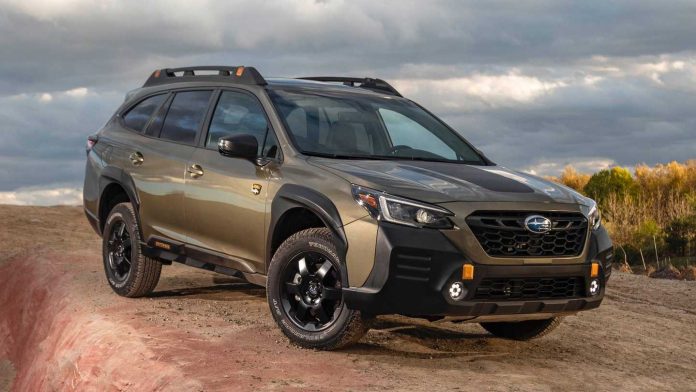

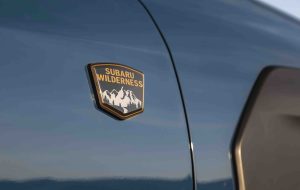
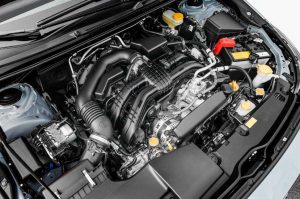

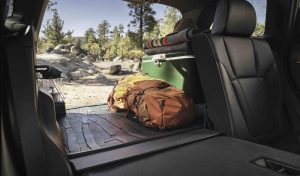








‘Lesbian car of the year’ — Ellen DG
Definitely, hideous old carpet muncher Hitlary would own a Forester, if she hadn’t stopped driving three decades ago.
As someone said elsewhere, if the sight of this demonic hag doesn’t make you want to commit murder, something’s seriously wrong with you. 🙂
No she wouldn’t. She would own a hired driver driven SUV tank as she does now paid for by you and the rest of the shrinking productive class. The Forester and its like appeal to real people not satanist whores.
Hi Eric,
You gave us plenty of details about the Subaru’s unique boxer engine. Thanks also for noting its relatively aggressive final drive ratio.
But somehow, you neglected to specify what kind of transmission “all” the models are equipped with. This information might help us to decide how desirable these Foresters really are…..or are not.
Enlighten us, please. 🙂
Hi Mike,
The Forester has a CVT – as almost all new Soobies have. As you know, I am not a big fan of them, but I will say this about Soobie’s CVTs: They have them set up to mimic the shifting characteristics of a conventional (geared) automatic; as you accelerate, you will see the RPMs climb, then drop as the CVT “shifts” into the next “gear” (range) and so on. The only thing missing is the physical sensation of the gears changing.
Soobie went with the CVT because of the mileage/efficiency advantages. These are often outweighed by the CVT’s often weird operating characteristics and excessive driveline noise under acceleration as well as (generally) not-so-great long-term reliability. But the former don’t manifest in this case and – given this Soobie’s engine isn’t especially powerful – the CVT is under less stress. But there is the inherent long-term durability issue as CVTs by their design are more prone to metal fatigue and – my understanding – aren’t repairable when they fail.
I would like this car much better with a six speed manual.
In fact, one of the few new/recent model cars I have though about getting for myself is the Crosstrek with the six speed. This is a fantastic little runabout that’s very practical and very fun – believe it or not – with the manual. But get one while you still can… because you soon won’t be able to get one.
That’s why when I went looking for a new Outback, I ended up with a certified pre owned one. It had an actual transmission with actual gears. None of those CVT things.
For a while I owned both a WRX with 265hp & 6-speed manual, and a Forester XT with 250hp & CVT. The Forester would beat the WRX on my favorite twisty mountain road. I finally figured out that this unexpected result was because the CVT is always in the right gear. The WRX is gone but I still have the XT.
Hi ft,
That’s true about the CVT; the general worry is the long-term reliability of them. I understand they have gotten better. I myself would still rather have the manual – for that reason and also because I am weirdo who likes to shift!
How possible would it be to just install a conventional transmission when the CVT breaks (since it’s not repairable anyway)? Or are they changing the engines enough so they don’t line up with a real geared trans or have too much reverse engineering to make electronic parts work?
The reality is we need much more third party parts and replacement software to counter unrepairable things that automaker will refuse to support (since they will want their old stuff off the road too). Maybe more possible when cars cost even more, and it makes repairing more viable. That solution of course will be limited to states without too much inspection (so no California).
Hi Rich,
It’s probably physically possible to make the swap but you’d likely need to replace the ECM with one set up for a conventional automatic, along with any related electronics. I think the question becomes – how much will all this cost and is the cost worth the trouble?
The cheap bastard in me loathes high trim models, as they typically have the same basic powertrain as the lower models but are much more $$$. This one is no exception. It basically offers a higher ground clearance, easy-clean seats, and a taller gear ratio. 4.11 vs 3.73. People: 3.71 is pretty tall to start with. The final gear ratio is a major factor in determining gas mileage. That’s why I got my 20 F150 with 3.55 gears vs the standard 3.73. The taller gear ratio *can* tow more, which is why the Forester Wilderness has a higher towing rating. However, at highway speeds, those 4.11 gears will be singing, and sucking fuel! My wife’s 05 Outback pulls >3000 RPM at 70 MPH, which is a little high in my estimation. In contrast, my F150 pulls less than 2000 for the same speed.
To get the ground clearance, you could lift the Soobs. Simplest way are some spacers that mount above the shocks. You have top of shock > spacer > car. So, you can get an easy 0.5″ this way, save yourself 5 grand, and save yourself the screaming highway RPM’s. That’s what I would do. YMMV
I just paid off my Outback 3.6R.
Should it explode mysteriously, this is the car I would get next.
I am seriously disappointed that Subaru has dropped the 3.6 liter six. Yes, it uses more gas than the four, but it gives me the power I need to climb hills and haul stuff without the expense and hassle of a turbo.
This new Wilderness isn’t showing me anything that makes me want to replace my 2017 XT.
Hi ft,
Your Soobie’s only five years old; I’d keep it, too!
You nailed some of the real positives of Subaru design. Simple and to the point without the overcomplication rampant today. The full dize spare is pretty sweet. I drive a manual crosstrek and its a good car. Doesn’t have the Eyesight nanny tech that’s on many of them and in fact very little tech at all. Peppy enough and its little boxer engine givess the nice puppy dog growl described in your review. Now throw a manual on this one and kill the ASS and you’ve got a really nice ride.
Also good point about the advantage of tall sidewalls. I owned a porsche 911 with low profile tires and curbs and potholes are merciless on them. Shredded two tires at once going over a raised manhole cover on a freezing Chicago night. Fun times!
Us too. 4 tires gone and two rims destroyed in about 2 years on a MB E350. For some reasons, probably looks, our local MB dealer ordered all their cars with the sport package with very low profile tire. We didn’t realize what problems they were till later. The worst part was changing them. Dangerous and almost deadly. I told my wife to f’it and drive the thing on the brake discs for all I care just to get off the interstate and potential death.
Got a grand cherokee.
It could be…But the overall design for any off road vehicle needs to be static to give enough time for the development of aftermarket parts. The Toyota 4Runner 5th Gen is 12 years old and it’s huge off road success is because of this. Versions of the Jeep as well.
Paul Hogan would be disappointed in this article, Eric. Then again, all SUVs look the same. You could have put a RAV4 as a picture and call it a Forester.
Having owned a Subie, you’ll also be assumed to have the typical Subaru owner politics. I always enjoyed disabusing people of that thought.
It seems like the brand may be returning, a little, to the Subies of my younger years. Of course, all the ASS and associated systems belie that, I think. Along with their CVTs. At least, as I understand it, the new ones are a Subaru CVT, not those b@st@rd Jatcos.
First thing I noticed in the pic was that this thing seems to have some clearance. So good lead photo.
If one can have a capable suv for $25k, that’s a win today.
I have the onyx with the turbo. Couldn’t deal with the slow acceleration of the non turbo. Came with a life time warranty on the turbo and the whole engine so hopefully it works out. 30k miles and no problems yet. Although no one seems to know if the transmission fluid should be changed or not…
Lesbian car of the year
Hi Ellen,
Subaru has that reputation. But I’ve never cared much for what others think about my ride. My truck is old and faded. It is not “hip” or “with it.” But I love it – and that’s all that ought to matter to anyone regarding their car.
LOL, I feel the same way about my 1990s Sable station wagon
Hi dood,
Those Sable (and Taurus) wagons were – are – great vehicles; I took a press Sable to Graceland, all the way across TN from VA. Only stopped to fill up and toss the 2 liter bottle of pee that had been Mountain Dew!
I think most of them moved to Prius’s.
Funny though as when my kid owned an STi my brother used to berate him “Looooovvvvveeee” like in the commercial that ran forever. haha.